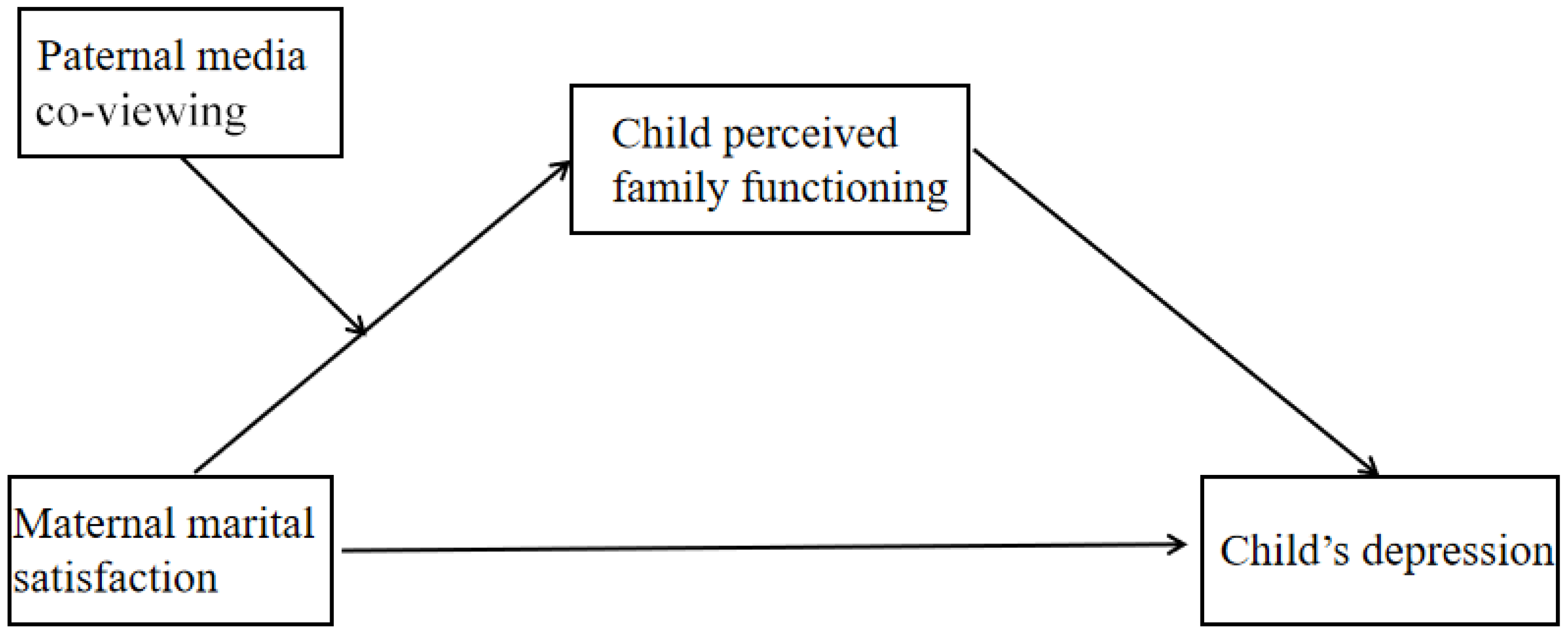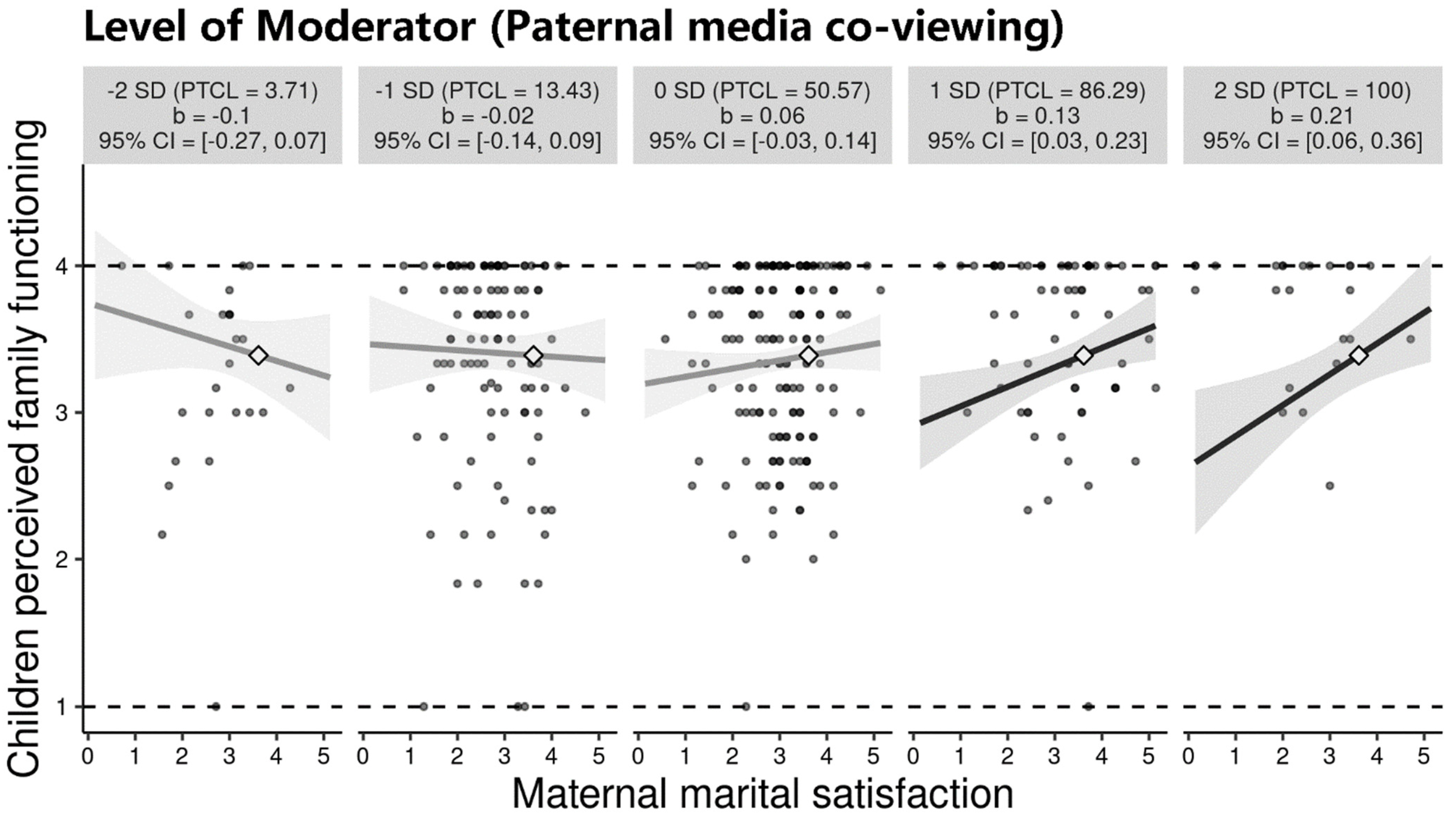Marital Satisfaction, Family Functioning, and Children’s Mental Health—The Effect of Parental Co-Viewing
Abstract
:1. Introduction
2. Literature Review
2.1. Marital Satisfaction and Family Functioning
2.2. Child’s Perceived Family Functioning and Their Depression and Anxiety
2.3. The Mediating Role of Child’s Perceived Family Functioning
2.4. Parent-Child Co-Viewing Moderate the Association between Marital Satisfaction and Family Functioning
2.5. Methods
2.6. Measures
2.7. Analytical Plan
3. Results
3.1. Preliminary Analysis
3.2. The Mediation Model
3.3. The Moderated-Mediation Model
4. Discussion
4.1. Theoretical Implications and Practical Implications
4.2. Limitations and Suggestions for Future Directions
5. Conclusions
Author Contributions
Funding
Institutional Review Board Statement
Informed Consent Statement
Data Availability Statement
Conflicts of Interest
References
- Bittner, A.; Egger, H.; Erkanli, A.; Costello, E.J.; Foley, D.L.; Angold, A. What do childhood anxiety disorders predict? J. Child Psychol. Psychiatry 2007, 48, 1174–1183. [Google Scholar] [CrossRef] [PubMed]
- Hofstra, M.B.; Van Der Ende, J.; Verhulst, F.C. Child and Adolescent Problems Predict DSM-IV Disorders in Adulthood: A 14-Year Follow-up of a Dutch Epidemiological Sample. J. Am. Acad. Child Adolesc. Psychiatry 2002, 41, 182–189. [Google Scholar] [CrossRef] [PubMed]
- Feldman, S.S.; Wentzel, K.R.; Weinberger, D.A.; Munson, J.A. Marital satisfaction of parents of preadolescent boys and its relationship to family and child functioning. J. Fam. Psychol. 1990, 4, 213–234. [Google Scholar] [CrossRef]
- Qian, Y.; Chen, F.; Yuan, C. The effect of co-parenting on children’s emotion regulation under fathers’ perception: A moderated mediation model of family functioning and marital satisfaction. Child. Youth Serv. Rev. 2020, 119, 105501. [Google Scholar] [CrossRef]
- Scully, C.; McLaughlin, J.; Fitzgerald, A. The relationship between adverse childhood experiences, family functioning, and mental health problems among children and adolescents: A systematic review. J. Fam. Ther. 2020, 42, 291–316. [Google Scholar] [CrossRef]
- Van Der Loos, H.F.M. Sherry Turkle. Alone Together: Why We Expect More from Technology and Less from Each Other. Sci. Eng. Ethics 2014, 20, 5–6. [Google Scholar] [CrossRef]
- Devitt, K.; Roker, D. The Role of Mobile Phones in Family Communication. Child. Soc. 2009, 23, 189–202. [Google Scholar] [CrossRef]
- Media, C.O.C.A.; Strasburger, V.C.; Hogan, M.J.; Mulligan, D.A.; Ameenuddin, N.; Christakis, D.A.; Cross, C.; Fagbuyi, D.B.; Hill, D.L.; Levine, A.E.; et al. Children, Adolescents, and the Media. Pediatrics 2013, 132, 958–961. [Google Scholar] [CrossRef] [Green Version]
- Connell, S.L.; Lauricella, A.R.; Wartella, E. Parental Co-Use of Media Technology with their Young Children in the USA. J. Child. Media 2015, 9, 5–21. [Google Scholar] [CrossRef]
- Pedro, M.F.; Ribeiro, T.; Shelton, K.H. Romantic Attachment and Family Functioning: The Mediating Role of Marital Satisfaction. J. Child Fam. Stud. 2015, 24, 3482–3495. [Google Scholar] [CrossRef]
- Pedro, M.F.; Ribeiro, T.; Shelton, K.H. Marital satisfaction and partners’ parenting practices: The mediating role of coparenting behavior. J. Fam. Psychol. 2012, 26, 509–522. [Google Scholar] [CrossRef]
- Greeff, A.P.; de Bruyne, T. Conflict Management Style and Marital Satisfaction. J. Sex Marital Ther. 2000, 26, 321–334. [Google Scholar] [CrossRef] [PubMed]
- Erel, O.; Burman, B. Interrelatedness of marital relations and parent-child relations: A meta-analytic review. Psychol. Bull. 1995, 118, 108–132. [Google Scholar] [CrossRef] [PubMed]
- Parke, R.D. Fathers and families. In Handbook of Parenting: Being and Becoming a Parent, 2nd ed.; Lawrence Erlbaum Associates Publishers: Mahwah, NJ, USA, 2002; Volume 3, pp. 27–73. [Google Scholar]
- Bornstein, M.H. Handbook of Parenting. Volume 3: Being and Becoming a Parent, 3rd ed.; Lawrence Erlbaum Associates, Inc.: Mahwah, NJ, USA, 2002; pp. 13–14. [Google Scholar]
- Almeida, D.M.; Wethington, E.; Chandler, A.L. Daily Transmission of Tensions between Marital Dyads and Parent-Child Dyads. J. Marriage Fam. 1999, 61, 49–61. [Google Scholar] [CrossRef]
- Fishman, E.A.; Meyers, S.A. Marital Satisfaction and Child Adjustment: Direct and Mediated Pathways. Contemp. Fam. Ther. 2000, 22, 437–452. [Google Scholar] [CrossRef]
- Alderfer, M.A.; Fiese, B.H.; Gold, J.I.; Cutuli, J.J.; Holmbeck, G.N.; Goldbeck, L.; Chambers, C.T.; Abad, M.; Spetter, D.; Patterson, J. Evidence-based Assessment in Pediatric Psychology: Family Measures. J. Pediatr. Psychol. 2007, 33, 1046–1061. [Google Scholar] [CrossRef] [Green Version]
- Infurna, M.R.; Reichl, C.; Parzer, P.; Schimmenti, A.; Bifulco, A.; Kaess, M. Associations between depression and specific childhood experiences of abuse and neglect: A meta-analysis. J. Affect. Disord. 2016, 190, 47–55. [Google Scholar] [CrossRef]
- Katz, L.F.; Low, S.M. Marital Violence, Co-Parenting, and Family-Level Processes in Relation to Children’s Adjustment. J. Fam. Psychol. 2004, 18, 372–382. [Google Scholar] [CrossRef]
- Faust, J.; Stewart, L.M. Impact of Child Abuse Timing and Family Environment on Psychosis. J. Psychol. Trauma 2008, 6, 65–85. [Google Scholar] [CrossRef]
- Shek, D.T.L. A Longitudinal Study of the Relationship between Family Functioning and Adolescent Psychological Well-Being. J. Youth Stud. 1998, 1, 195–209. [Google Scholar] [CrossRef]
- Kelada, L.; Hasking, P.; Melvin, G. The Relationship Between Nonsuicidal Self-Injury and Family Functioning: Adolescent and Parent Perspectives. J. Marital Fam. Ther. 2016, 42, 536–549. [Google Scholar] [CrossRef]
- Nagaraja, A.; Rajamma, N.M.; Reddy, S.V. Effect of Parents’ Marital Satisfaction, Marital Life Period and Type of Family on their Children Mental Health Status. J. Psychol. 2012, 3, 65–70. [Google Scholar] [CrossRef]
- Valkenburg, P.M.; Krcmar, M.; Peeters, A.L.; Marseille, N.M. Developing a scale to assess three styles of television mediation: “Instructive mediation,” “restrictive mediation,” and “social coviewing”. J. Broadcast. Electron. Media 1999, 43, 52–66. [Google Scholar] [CrossRef]
- Valkenburg, P.M.; Piotrowski, J.T.; Hermanns, J.; de Leeuw, R. Developing and Validating the Perceived Parental Media Mediation Scale: A Self-Determination Perspective. Hum. Commun. Res. 2013, 39, 445–469. [Google Scholar] [CrossRef]
- Beyens, I.; Beullens, K. Parent–child conflict about children’s tablet use: The role of parental mediation. New Media Soc. 2016, 19, 2075–2093. [Google Scholar] [CrossRef]
- Nathanson, A.I. The Unintended Effects of Parental Mediation of Television on Adolescents. Media Psychol. 2002, 4, 207–230. [Google Scholar] [CrossRef]
- Nathanson, A.I. Parent and Child Perspectives on the Presence and Meaning of Parental Television Mediation. J. Broadcast. Electron. Media 2001, 45, 201–220. [Google Scholar] [CrossRef]
- Salomon, G. Effects of Encouraging Israeli Mothers to Co-Observe “Sesame Street” with Their Five-Year-Olds. Child Dev. 1977, 48, 1146–1151. [Google Scholar] [CrossRef]
- Zabriskie, R.B.; McCormick, B. The Influences of Family Leisure Patterns on Perceptions of Family Functioning*. Fam. Relat. 2001, 50, 281–289. [Google Scholar] [CrossRef]
- Wang, J.; Shi, X.; Yang, Y.; Zou, H.; Zhang, W.; Xu, Q. The Joint Effect of Paternal and Maternal Parenting Behaviors on School Engagement Among Chinese Adolescents: The Mediating Role of Mastery Goal. Front. Physiol. 2019, 10, 1587. [Google Scholar] [CrossRef] [Green Version]
- Padilla-Walker, L.M.; Coyne, S.M.; Fraser, A.M. Getting a High-Speed Family Connection: Associations Between Family Media Use and Family Connection. Fam. Relat. 2012, 61, 426–440. [Google Scholar] [CrossRef]
- Hunsley, J.; Best, M.; Lefebvre, M.; Vito, D. The Seven-Item Short Form of the Dyadic Adjustment Scale: Further Evidence for Construct Validity. Am. J. Fam. Ther. 2001, 29, 325–335. [Google Scholar] [CrossRef]
- De Haan, K.L.B.; Hafekost, J.; Lawrence, D.; Sawyer, M.G.; Zubrick, S. Reliability and Validity of a Short Version of the General Functioning Subscale of the McMaster Family Assessment Device. Fam. Process 2015, 54, 116–123. [Google Scholar] [CrossRef] [PubMed]
- Ebesutani, C.; Reise, S.P.; Chorpita, B.F.; Ale, C.; Regan, J.; Young, J.; Higa-McMillan, C.; Weisz, J.R. The Revised Child Anxiety and Depression Scale-Short Version: Scale reduction via exploratory bifactor modeling of the broad anxiety factor. Psychol. Assess. 2012, 24, 833–845. [Google Scholar] [CrossRef] [Green Version]
- Hayes, A.F. Introduction to Mediation, Moderation, and Conditional Process Analysis: A Regression-Based Approach; The Guilford Press: New York, NY, USA, 2013. [Google Scholar]
- McCabe, C.J.; Kim, D.S.; King, K.M. Improving Present Practices in the Visual Display of Interactions. Adv. Methods Pract. Psychol. Sci. 2018, 1, 147–165. [Google Scholar] [CrossRef] [PubMed]
- Mesch, G.S. Family characteristics and intergenerational conflicts over the Internet. Inf. Commun. Soc. 2006, 9, 473–495. [Google Scholar] [CrossRef]


| Variable | M | SD | 1 | 2 | 3 | 4 | 5 | 6 |
|---|---|---|---|---|---|---|---|---|
| 1. Paternal marital satisfaction | 2.94 | 0.92 | 1 | |||||
| 2. Maternal marital satisfaction | 2.90 | 0.91 | 0.78 *** | 1 | ||||
| 3. Paternal co-viewing | 3.14 | 0.94 | 0.35 *** | 0.25 *** | 1 | |||
| 4. Maternal co-viewing | 3.19 | 0.91 | 0.05 | 0.26 *** | 0.68 *** | 1 | ||
| 5. Child’s perceived family functioning | 0.82 | 0.57 | 0.10 * | 0.13 * | 0.04 | 0.09 | 1 | |
| 6. Child’s anxiety | 0.57 | 0.52 | −0.11 * | −0.09 | 0.05 | 0.01 | −0.29 *** | 1 |
| 7. Child’s depression | 3.33 | 0.62 | −0.09 | −0.11 * | −0.03 | 0.01 | −0.38 *** | 0.76 *** |
| Child’s Perceived Family Functioning | Depression | |||||||
|---|---|---|---|---|---|---|---|---|
| Predictors | B | SE | LLCI | ULCI | B | SE | LLCI | ULCI |
| Constant | 3.91 | 0.41 | 3.10 | 4.72 | 1.75 | 0.18 | 1.40 | 2.11 |
| Maternal marital satisfaction | −0.20 | 0.13 | −0.46 | 0.06 | −0.06 | 0.03 | −0.12 | 0.01 |
| Child’s perceived family functioning | −0.35 | 0.04 | −0.44 | −0.27 | ||||
| Paternal co-viewing | −0.20 | 0.13 | −0.46 | 0.06 | ||||
| Paternal co-viewing × Child’s perceived family functioning | 0.08 | 0.04 | 0.01 | 0.16 | ||||
| R2 | 0.03 * | 0.18 *** | ||||||
| Conditional indirect effects of maternal marital satisfaction on depression at a value of paternal co-viewing through children perceived family functioning | ||||||||
| Paternal co-viewing | Effect | Boot SE | Boot LLCI | Boot ULCI | ||||
| −1 SD | 0.007 | 0.022 | −0.037 | 0.051 | ||||
| M | −0.020 | 0.017 | −0.055 | 0.011 | ||||
| +1 SD | −0.048 | 0.021 | −0.091 | −0.011 | ||||
| Index of moderated mediation mediator | Index | Boot SE | Boot LLCI | Boot ULCI | ||||
| −0.029 | 0.014 | −0.059 | −0.002 | |||||
Publisher’s Note: MDPI stays neutral with regard to jurisdictional claims in published maps and institutional affiliations. |
© 2022 by the authors. Licensee MDPI, Basel, Switzerland. This article is an open access article distributed under the terms and conditions of the Creative Commons Attribution (CC BY) license (https://creativecommons.org/licenses/by/4.0/).
Share and Cite
Du, X.; Liang, M.; Mu, W.; Li, F.; Li, S.; Li, X.; Xu, J.; Wang, K.; Zhou, M. Marital Satisfaction, Family Functioning, and Children’s Mental Health—The Effect of Parental Co-Viewing. Children 2022, 9, 216. https://doi.org/10.3390/children9020216
Du X, Liang M, Mu W, Li F, Li S, Li X, Xu J, Wang K, Zhou M. Marital Satisfaction, Family Functioning, and Children’s Mental Health—The Effect of Parental Co-Viewing. Children. 2022; 9(2):216. https://doi.org/10.3390/children9020216
Chicago/Turabian StyleDu, Xianxian, Mengjiao Liang, Weiqi Mu, Fugui Li, Siying Li, Xue Li, Jie Xu, Kexin Wang, and Mingjie Zhou. 2022. "Marital Satisfaction, Family Functioning, and Children’s Mental Health—The Effect of Parental Co-Viewing" Children 9, no. 2: 216. https://doi.org/10.3390/children9020216
APA StyleDu, X., Liang, M., Mu, W., Li, F., Li, S., Li, X., Xu, J., Wang, K., & Zhou, M. (2022). Marital Satisfaction, Family Functioning, and Children’s Mental Health—The Effect of Parental Co-Viewing. Children, 9(2), 216. https://doi.org/10.3390/children9020216





